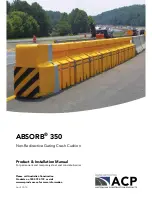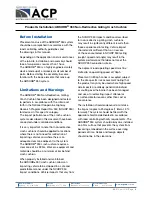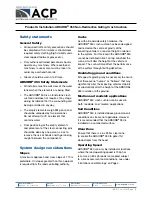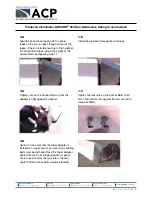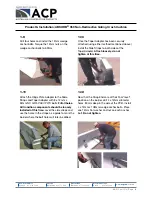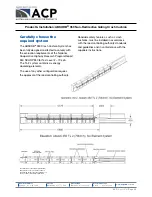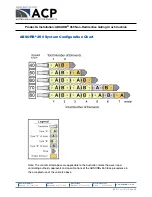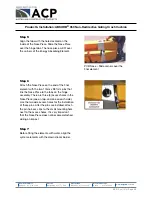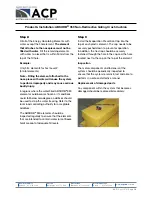
New South Wales
Sydney
02 8708 4400
Victoria
Melbourne
03 8773 5300
Queensland
Brisbane
07 3442 6200
Western Austalia
Perth
02 8708 4400
www.
acprod
.com.au
ACP
|
April 2016
|
Page
5
Product & Installation: ABSORB
®
350 Non-Redirective Gating Crash Cushion
Safety statements
General Safety
>
All required traffic safety precautions should
be complied with. All workers should wear
required safety clothing (high visibility vests,
steel capped footwear, gloves etc.)
>
Only authorised trained personnel should
operate any machinery. Where overhead
machinery is used, care must be taken to
avoid any overhead hazards.
>
Gloves should be worn at all times.
ABSORB
®
350 Safety Statements
>
All installers must be well clear of the water
tanker when the elements are being filled.
>
The ABSORB
®
350 is a stand alone crash
cushion and does not require at any stage
during installation that the surrounding soil
be dug or drilled in anyway.
>
The empty elements weigh 39kg each and
should be unloaded by two personnel.
Do not attempt to lift an element that
contains water.
>
Final positioning of the empty elements
and placement of the steel connecting pins
should be done by one person, so as to
remove the risk of hands and fingers being
caught between the components.
System design considerations
Slopes
A maximum approach and cross slope of 1:10 is
preferable. On slopes greater than this, approval
is required from the road controlling authority.
Curbs
As with all road side safety hardware, the
ABSORB
®
350 crash cushion has been designed
and tested so the centre of gravity of the
impacting vehicle is a constant height in relation
to the system. For this reason the ABSORB
®
350
cannot be installed in front, on top or behind the
curb as it will alter the height of the vehicle at
impact. The curb will also affect the performance
of the system through limiting deflection.
Undulating ground conditions
Site specific grading may be necessary to ensure
that there are no “humps” or “hollows” that may
significantly alter the impacting vehicles stability
or substantially alter the height of the ABSORB
®
350 in relation to the ground.
Median and roadside applications
ABSORB
®
350 crash cushion can be used in
both ‘roadside’ and ‘median’ applications.
Soil Conditions
ABSORB
®
350 is installed above ground so soil
conditions on site are not applicable. However
it is recommended that the ABSORB
®
350 is
installed on a compacted surface.
Clear Zone
Ensure that there is a 6 x 22.5m clear zone
to enable the ABSORB
®
350 to gate if hit
downstream from the head.
Operating Speed
ABSORB
®
350 can only be installed at locations
where the road operating speed is 70kph or
less. Use on 80 kph roads is accepted subject
to a risk assessment and conditions, see under
‘Limitations and Warnings’ on Page 4.

